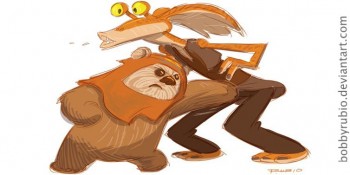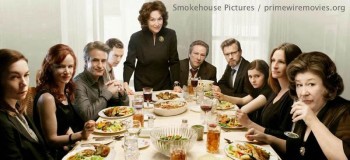A friend of mine once stated that if he had a DeLorean time machine, he would travel back to 1997 to stop George Lucas from creating the Star Wars prequels. Conversely, when people ask me about my favorite movie, I always declare Star Wars, as a whole, as the greatest cinematic tale ever told. All six episodes (so far) of the space opera combine to be my favorite movie. My friend and I have a lot of shared interests and are only a few years apart in age. So why is it that we have such different opinions about the prequel trilogy?
The answer was offered, though indirectly, in an episode of How I Met Your Mother. In the episode, Barney Stinson explains the “Ewok line” — the line which determines whether you liked or hated the Ewoks. The Ewoks were the most controversial part of the original Star Wars trilogy
, appearing in Return of the Jedi to help bring down the Empire, despite their complete lack of technology and laughably small numbers. As Barney explained, people born after 1973 love the Ewoks — they were under 10 years old at Jedi’s release — while those born before then find the Endorians infuriating. This line, though created to explain disillusionment with Return of the Jedi, works perfectly as an explanation for the problems some fans have with the Star Wars prequels.
I was nine years old when The Phantom Menace was released; my friend was 12. Every single person I’ve ever argued with about the prequels was older than me by at least a year, placing them on the opposite side of this updated “Ewok line.” Most fans of the prequels I’ve met are my age or younger — or didn’t see the originals before The Phantom Menace. The phenomenon is uncanny.
So what is it about turning 10 that changes our perspective about the movies?
To begin with, Star Wars movies are made for the entire family. Each episode can be seen through entirely different lenses, depending on your age when watching. To a child, the Ewoks are adorable and relatable. They’re the biggest underdogs imaginable in a fight with a Galactic Empire, yet they survive. They exist to show us that there is always hope, and even the weakest among us have strength.
The Phantom Menace’s largest controversy was over Jar Jar Binks. To this day, I cannot understand the visceral hatred of the Gungan. Of course, I also watched him when I was a child. To me, Jar Jar was hilarious. There was nothing infuriating about his antics. Sure, Jar Jar was a bumbling fool, but so were the Three Stooges, and everybody loved them.
If you’re older, yes, Jar Jar can be annoying, but then you aren’t the target audience for the character. Jar Jar, even with his diminished role, matures in the films, as does his audience: the fans who were under 10 when The Phantom Menace was released. As one of those fans, I remember finding Jar Jar’s growth into the role of leader to be inspiring. The older audience, however, just can’t get over the problems they had with him when first watching Episode I.
A much larger roadblock to enjoying the prequels, however, is simple nostalgia. Fans who were over the age of 10 when The Phantom Menace was released already had fond memories of the original Star Wars trilogy. Those who saw the movies during the 70s and 80s were especially prejudiced by this fact, as the original movies were part of their childhoods. To them, the original movies were perfect, and the announcement of Episode I was akin to hearing that your dead father was returning from the grave to toss the ball around in the yard once more. It was a chance for these fans to return to a simpler time of life that they’d all grown to miss. To true Star Wars fans, the idea of returning to a galaxy far, far away, was overwhelming.
That kind of nostalgia creates unrealistic expectations. Fans of the original trilogy anticipated a film that would recreate the magic of their youth. That is an impossible standard. Whereas I watched the pod race scene and was left in awe and wonder, older fans saw a long scene about an annoying child. When I watched Darth Maul and Obi-Wan Kenobi duel to the death, it was a struggle between good and evil masters of a mystic martial art, whereas older fans saw an overly choreographed dance with a villain who could never be Darth Vader.
Nostalgia made sure The Phantom Menace didn’t stand a chance, and that resentment carried over to the following movies. Perhaps nostalgia has had the same effect on me, causing me to argue unapologetically for a movie from my own youth. This idea was present in my mind when Episode I was rereleased in 3D a few years ago, causing me to watch the film with a skeptical eye. I re-viewed The Phantom Menace and its two sequels, looking out for those parts of the movie that received the most audible criticism, and I found those arguments to be strongly lacking. In fact, I found even more about the movies to love.
Possibly the biggest criticism of The Phantom Menace is the introduction of midi-chlorians. OK, the idea that the Force was relegated to microscopic bacteria is infuriating — but it’s also not what happened. Midi-chlorians are microscopic lifeforms that exist within all living beings, allowing them to hear the will of the Force. They are not, themselves, the Force but a bridge from more complex forms of life to the simple. They exist more prominently in Force wielders and allow the host to more easily connect with the energy field. They are used only to measure Force-sensitive potential, not actual power. Anakin Skywalker was said to have a higher midi-chlorian count than even Master Yoda, yet at no time in the entire series is Darth Vader shown to be stronger in the Force than the Jedi legend.
Another bogus criticism is that The Phantom Menace lacks a lead character. So does The Avengers, but that doesn’t make it a bad movie. Star Wars movies always have featured ensemble casts. While it’s easy to point at Luke Skywalker as the protagonist of the original trilogy, the movies were just as much about Han Solo and Leia Organa — and the droids probably get more screen time than even Luke. Episode I, like Episode IV, has four primary characters: Kenobi, Anakin Skywalker, Qui-Gon Jinn, and Padme Amidala.
Jinn is the mentor of the movie, taking the role Kenobi filled in A New Hope, guiding the other three characters toward their goals. He helps to teach Amidala to listen to others when making decisions, teaches Anakin about the Force and its potential within him, and pushes Kenobi toward critical thinking, even when dealing with the revered Jedi Order. At the end of the movie, all three young characters fulfill their potential. When Master Qui-Gon meets his untimely demise, Kenobi must quickly rise to the occasion, just as Luke must in Episode IV. Meanwhile, Anakin and Amidala also mirror the actions of their future children, using their wits and luck to bring down the Trade Federation.
Another complaint about the Star Wars prequels is also linked to expectation. Old Star Wars fans remembered a story about a ragtag group of rebels fighting impossible odds and expected to see the same thing in the newer trilogy. However, the prequels were never going to be able to recreate that atmosphere. Instead, these movies are about the downfall of an advanced society and the spiral of a democracy toward tyranny. The entire point of these movies was that evil isn’t always as easy to spot as Darth Vader or the Emperor. Sometimes, the most evil men hide in plain sight.
The brilliance of the prequels is in the rise to power of Emperor Palpatine. Every scene with Palpatine shows his conniving and manipulating on full display, his every move perfectly planned out to push him closer to his goals of domination. When viewed in this light, the prequels become stronger tragic tales about how tenuous our own republic is. They tell the story of how even the mightiest governments can fall when the leaders succumb to the influence of outside power and promises of grandeur.
Anakin’s fall is a great story to tell, even if Hayden Christensen was not the greatest actor to tell it. I will concede that Christensen’s performance in Attack of the Clones took me out of the movie at times, but I can’t say that he didn’t nail the whiny teenager bit. Still, Ewan McGregor’s performance on Kamino is brilliant. The eerie questions surrounding the cloners further pushed the brilliant plan of Palpatine and his minions while leading to the beginning of a war, completely manufactured by a Chancellor striving for power.
The Clone Wars, as shown in the eponymous series as well as Revenge of the Sith, completely change the mentality of the Jedi Order, pushing them into the position of war generals. Palpatine’s genius is shown here as the war acts to distract the Jedi while creating a generation of young adults, like Anakin, who are sick of fighting and are more beholden to the concept of an authoritarian government willing to punish enemies of peace.
Anakin’s behavior and seemingly abrupt shift to the Dark Side makes sense in this context, as we remember that Anakin expressed a belief that even strong-arm tactics are justifiable as long as they lead to a greater good. He sees during the Clone Wars that the Jedi’s pacifistic tactics have only led to continuing battles and death. The Separatists are like petulant children in Anakin’s eyes. They are the minority who must be repressed to make the majority of the galaxy better. And when Anakin is put into the position to choose between the Jedi, who kept the war going, and the Chancellor, who mentored him and helped him to bring an abrupt end to the fighting, he chooses the Chancellor.
Palpatine acts as the snake in the Garden of Eden. He offers Anakin a Faustian bargain, promising to save Anakin’s wife in exchange for his apprenticeship. The Jedi, in Anakin’s view, are limited by their dogma from doing what is right. In this sense, Anakin is a bit of a utilitarian, willing to make questionable decisions for a greater good. He also acts as a reflection on post-9/11 America and its use of questionable tactics in the name of security.
If you are a fan of science fiction, you should watch the Star Wars prequels fairly, without the prejudice in your mind of what a Star Wars movie should be. Lucas created a universe. He gave us a sandbox in which stories old and new could be expressed in a unique way. There is no singular formula to create a Star Wars movie. Therefore, Lucas can make a movie about space pirates and rebels, or he can write an allegory about how easily democracy can crumble.
Now that the reins have been passed on to J.J. Abrams, I look forward to seeing how the Star Trek director plays with Lucas’ sandbox. I, however, will not hold him to impossible expectations about what a Star Wars movie should be. I will not be angry if an old sage proves to be a tremendous swordsman, or if a collection of tribal bears brings down a war machine. I will be happy with the story that is being told to me, and I will be thankful that Lucas was willing to hand over his creation to a new generation of artists to continue his work.
I look forward to every story that can be told in the galaxy far, far away, and I hope you will join me in theaters in December 2015 for the next chapter in the Star Wars saga.

